Processing Your Payment
Please do not leave this page until complete. This can take a few moments.
- News
-
Editions
View Digital Editions
Biweekly Issues
- May 13, 2024
- April 29, 2024
- April 15, 2024
- April 1, 2024
- March 18, 2024
- March 4, 2024
- February 19, 2024
- February 5, 2024
- January 22, 2024
- + More
Special Editions
- Lists
- Viewpoints
- HBJ Events
- Business Calendar
- Custom Content
‘We’ll get through this.’ Head of Saint Francis Hospital talks about management in a time of crisis
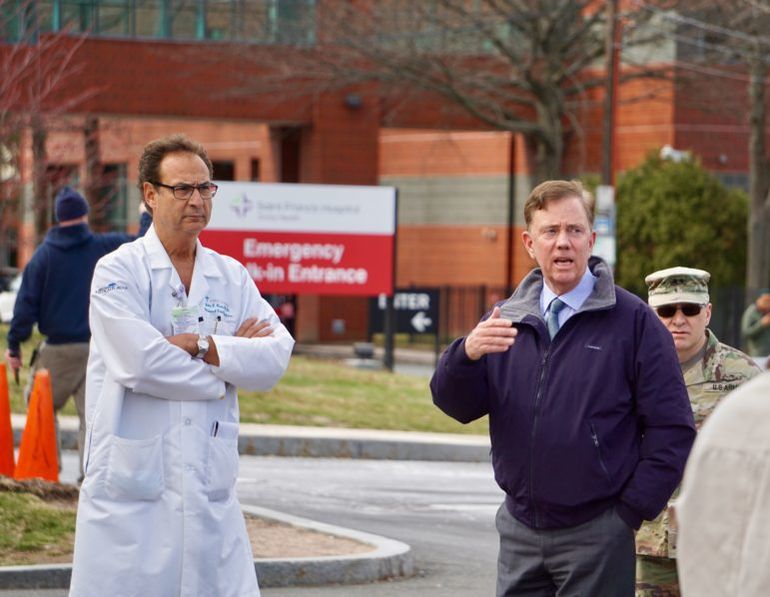 Photo | CT Mirror/Mark Pazniokas
Gov. Ned Lamont and Dr. John Rodis watch a mobile hospital being erected outside St. Francis Hospital and Medical Center.
Photo | CT Mirror/Mark Pazniokas
Gov. Ned Lamont and Dr. John Rodis watch a mobile hospital being erected outside St. Francis Hospital and Medical Center.
Dr. John Rodis remembers the flurry of activity at Stamford Hospital after the planes hit the twin towers in September 2001.
Administrators flung into action, anticipating a rash of patients.
“I saw how quickly a hospital could respond,” said Rodis, who was head of the emergency response team at that time. “We emptied half the building in six hours and built an FAA heliport, ready to go.”
“It was probably one of the saddest days of my life,” he said. “No victims came.”
During his 40-year career in medicine and leadership, Rodis, now president of Saint Francis Hospital and Medical Center in Hartford, has navigated the SARS and MERS outbreaks, weathered a battle over Connecticut’s hospital tax, managed a flu epidemic and seen hospitals through financial crises.
These experiences helped prepare him for the daunting task of running Saint Francis amid the COVID-19 pandemic.
In recent weeks, that has meant overseeing the erection of a mobile care center – a voluminous tent on the hospital’s campus with 25 additional beds – managing an unprecedented drop in revenue after elective surgeries were canceled and emergency room visits plunged, rallying equipment and staff to meet a surge in coronavirus patients, and reassuring families who are barred from visiting their hospitalized loved ones.
“I’m at the point in my career where you kind of think, Oh, I’ve done everything there is to do,” Rodis, 64, said in a recent interview with the CT Mirror. “And then things like this come along that remind you how you still have a lot to learn.”
At the end of last week, Saint Francis had more than 40 patients on ventilators. On a typical day, about 25 people might need those devices, he said.
Half of the hospital’s patients have tested positive for coronavirus or are awaiting results.
The National Guard helped clear out an auditorium and two large conference rooms at Saint Francis so staff could lay down cots. Rodis toured a nearby magnet school with city of Hartford officials, deeming the building fit to set up another 60 beds for overflow patients.
“I hope and pray that we won’t need any of these beds,” he said. “But my job is to be prepared.”
Rodis and his team arranged to have N95 masks sterilized for reuse while awaiting new shipments. Staffers sprang into action, purchasing 3D printers to create their own equipment. Rodis’ dry cleaner has begun making masks out of a special material used to wrap surgical instruments. The masks are being distributed to frontline workers.
Rodis also tapped his network of colleagues and friends for assistance. The Hospital for Special Care in New Britain, which has a longstanding relationship with Saint Francis, sent five ventilators to the Hartford hospital.
Other resources are being shared among the medical facilities that are part of Trinity Health, Saint Francis’ parent company.
“I feel fortunate in many ways to be in the position I’m in at this time,” Rodis said. “I hope my years of experience and the maturity that comes with it are helping.”
New pandemic routine
In addition to the long days at work, Rodis has adopted an exhaustive routine when he arrives home.
He sheds his hospital scrubs in the garage, tossing them in the washer with bleach. He soaks his hands in sanitizer before gripping the doorknob. From there, it’s straight to the shower.
“I’m a parent. I’m a husband,” he said. “You worry about your loved ones getting this. I worry, can I get this and bring it home? So I go through a fairly rigorous ritual to avoid that.”
Rodis and his wife Marytherese have been married for 33 years.
Rodis and his wife of 33 years, Marytherese, live in Farmington. They have three adult daughters.
At Saint Francis, he washes his hands frequently and wears a mask. He has swapped his usual business suits for the familiar blue scrubs.
No one is immune to the disease, certainly not hospital executives. Kurt Barwis, the president and CEO of Bristol Hospital – a friend of Rodis – tested positive for coronavirus last month.
“I called Kurt to ask how he’s doing, and he said, ‘I think I’m getting better,’” Rodis said. “I asked, ‘Why do you say that?’ And he goes, ‘Well, because last night I woke up at three in the morning and started thinking about ventilators and where I could put more patients.’ Before that, he was sick and sleeping through the night. So that gives you some insight into how hospital presidents are thinking.”
Rodis draws on a wide background to manage Saint Francis through the crisis, including a previous stint at the hospital early in his career. He started there as a maternal-fetal medicine fellow in 1985 and was named its eighth president in 2015. In between, he was head of obstetrics and gynecology at Stamford Hospital, served as its chief medical officer, was a faculty member at the UConn School of Medicine, and became chair of OB-GYN at Saint Francis in 2011.
He received a bachelor’s degree in biology from Cornell University, a medical degree from the Autonomous University of Guadalajara, and a Master of Business Administration from Rensselaer Polytechnic Institute.
Colleagues said Rodis’ compassion with patients and hospital staff is an asset during the pandemic. He is the first doctor to be appointed president at Saint Francis.
“He’s very caring and credible, both as a physician and as an executive,” said Jack Reed, the former CEO of ProHealth Physicians. “I think very highly of him in terms of the compassion he shows for patients and the providers. Being a health care provider himself, he has a unique sensitivity to what the providers need.”
Jennifer Jackson, president and CEO of the Connecticut Hospital Association, said Rodis has helped his hospital and others prepare for a surge in patients.
“I’ve seen that John, along with others, has really jumped into the coordination that we do and say, ‘OK, I have a responsibility to get my hospital ready. But I also have a responsibility in the interest of making sure the whole system is ready,'” she said. “John is particularly good at being collaborative.”
Financial issues
Since the outbreak began in Connecticut, Saint Francis, like other hospitals, has canceled its elective surgeries – a key source of revenue. And while thousands of state residents have been hospitalized with coronavirus, emergency room visits – another source of income – have dropped by 50%. That’s because motor vehicle crashes and work-related injuries are down, and people who typically go to the emergency department for a cut or sprained ankle are managing at home to avoid exposure.
Philanthropy, a critical resource for hospitals, also slows down as the economy sinks into recession.
Rodis estimated that Saint Francis’ revenue had fallen by about 50% since the pandemic started. At the same time, the need for additional protective gear and medical personnel pushed costs way up.
“We’re in the throes of this,” he said, “and essentially, we’re all hemorrhaging.”
One of the relief measures Congress enacted last month will pump $35 billion in emergency Medicaid funds into the states, including an estimated $440 million for Connecticut.
But health care advocates and lawmakers say the funding, while appreciated, represents a fraction of what hospitals, nursing homes, clinics, community-based social service groups and other care providers will need to survive the pandemic.
Rodis called the stimulus money “a great first step,” but said more is needed.
“It sounds like a big number, but when you start dividing it by 5,000 hospitals” nationally, he said, perspective sets in.
A longstanding battle over a tax on Connecticut’s hospitals has also complicated finances in recent years.
Hospital leaders warned they’d been bleeding funds for much of the past decade through the provider tax enacted under former Gov. Dannel P. Malloy. The tax, which sparked an industry lawsuit, drained $1.7 billion from hospitals between 2012 and 2019 — more than $240 million per year on average.
Rodis opened a news conference in March about the state’s preparedness for COVID-19, before social distancing rules had gone into effect.
Rodis said the tax didn’t hamper hospitals’ readiness for the pandemic, but it still took a toll. Investments in equipment, facilities and staff were delayed.
“There’s no doubt it took a lot of money out of hospitals,” Rodis said. “The vagaries of, year to year, not knowing whether money was coming or going, how much it was going to be, that was the biggest challenge.”
Earlier this month, as the number of coronavirus cases escalated, Trinity Health of New England, which operates Saint Francis and three other Connecticut hospitals, announced it would temporarily furlough some non-clinical workers across its system, though it didn’t say how many employees or which facilities would be affected.
Trinity Health also said it planned to reduce compensation for executives, reduce discretionary spending and halt capital expenditures, except those necessary to fight the pandemic.
‘We’ll get through this’
In recent weeks, Rodis has tried to quell fears over a lack of personal protective gear at his hospital.
Frontline workers, including nurses, from hospitals across the state have complained of shortages and having to work in unsafe conditions.
For now, Saint Francis has adequate supplies of masks, gowns, gloves, COVID-19 tests and other equipment, he said.
“There’s a lot of fear and anxiety,” he said. “We’re human beings at end of the day, and the same fear and anxiety that the public is feeling, health care workers are feeling it, too.”
When it comes to ventilators and making life-or-death decisions about who gets one, Rodis said Connecticut is unlikely to face the difficult quandaries that doctors in Italy and even nearby New York have had to contend with.
“I don’t think we’re going to be in a situation where we’re going to have to ration,” he said. “It’s an uncomfortable discussion to have, obviously, but it’s a discussion that shouldn’t have to happen.”
Rodis addressing the media in front of the mobile hospital.
Still, Rodis is encouraging people to write living wills or other advanced directives to guide physicians should the patient be unable to communicate during an emergency. “Of course everyone should be treated the same,” he said. “But you really have to think about the resource utilization at one end. And I would rather it’s not me deciding whether you go on the ventilator.”
One of the most challenging shifts has been restricting visitors, leaving sick patients alone during a scary ordeal.
Saint Francis still allows visitors in certain circumstances, such as an end-of-life situation, but has significantly limited who can come into the hospital.
“One of the saddest parts of this whole story really has been the severe restrictions we’ve had to put on visitation to protect people from getting infected,” Rodis said. “Patients are in their rooms alone except for when we’re interacting with them. That’s an important issue, how sad and lonely it is to be alone in a hospital. I can’t imagine a worse scenario.”
Parts of Connecticut are bracing for a surge of patients in the coming weeks. The southwestern corner and south-central areas have been hardest hit, and a new wave of patients is expected in the north-central counties by mid-to-late May.
With extra beds and resources at the ready, Rodis said Saint Francis is poised to meet the growing demand for care.
“I hear my father’s voice in the back of my head talking about how America mobilized during World War II and how companies that were making cars almost seemingly overnight started making jeeps and tanks and bombers; how my great aunt started making Springfield rifles,” he said. “I find a lot of solace and comfort knowing that America will respond. We’ll get through this.”
Related Content

2022 Giving Guide
This special edition informs and connects businesses with nonprofit organizations that are aligned with what they care about. Each nonprofit profile provides a crisp snapshot of the organization’s mission, goals, area of service, giving and volunteer opportunities and board leadership.
Learn more
Subscribe
Hartford Business Journal provides the top coverage of news, trends, data, politics and personalities of the area’s business community. Get the news and information you need from the award-winning writers at HBJ. Don’t miss out - subscribe today.
Subscribe
2024 Book of Lists
Delivering Vital Marketplace Content and Context to Senior Decision Makers Throughout Greater Hartford and the State ... All Year Long!
Read Here-
2022 Giving Guide
This special edition informs and connects businesses with nonprofit organizations that are aligned with what they care about. Each nonprofit profile provides a crisp snapshot of the organization’s mission, goals, area of service, giving and volunteer opportunities and board leadership.
-
Subscribe
Hartford Business Journal provides the top coverage of news, trends, data, politics and personalities of the area’s business community. Get the news and information you need from the award-winning writers at HBJ. Don’t miss out - subscribe today.
-
2024 Book of Lists
Delivering Vital Marketplace Content and Context to Senior Decision Makers Throughout Greater Hartford and the State ... All Year Long!
ABOUT
ADVERTISE
NEW ENGLAND BUSINESS MEDIA SITES
No articles left
Get access now
In order to use this feature, we need some information from you. You can also login or register for a free account.
By clicking submit you are agreeing to our cookie usage and Privacy Policy
Already have an account? Login
Already have an account? Login
Want to create an account? Register
Get access now
In order to use this feature, we need some information from you. You can also login or register for a free account.
By clicking submit you are agreeing to our cookie usage and Privacy Policy
Already have an account? Login
Already have an account? Login
Want to create an account? Register





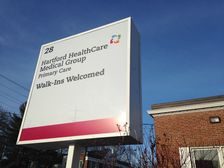
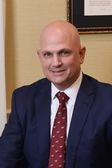
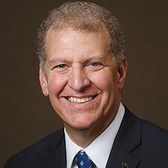
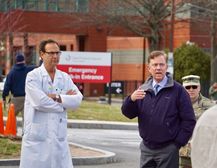
0 Comments